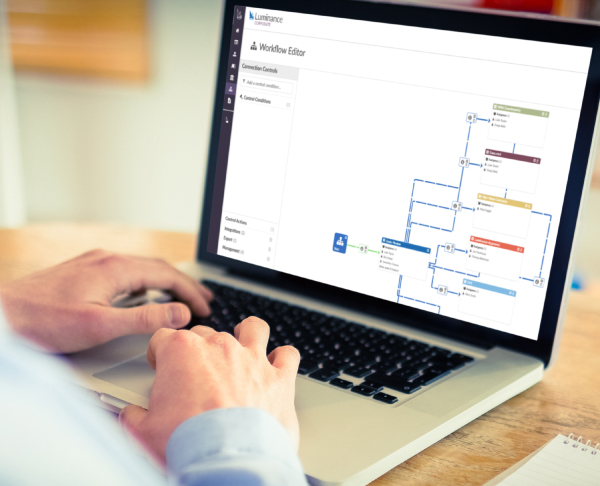
Blog
Luminance for Procurement: Empowering Non-Legal Teams with AI
18 November 2022 | Luminance
Contracts are the lifeblood of any procurement team. They define the key obligations and relationships that exist between businesses and their suppliers. Yet, despite contracts being central to the procurement process, 83% of procurement professionals admit that less than half of their work is automated, leaving organisations open to bottlenecks, inefficiencies and the risk of non-compliance.
Here, we take a closer look at how next-generation AI is allowing procurement teams to eliminate contract bottlenecks and barriers to institutional knowledge, all whilst ensuring compliance with internal standards throughout the commercial process.
The Challenges Facing Procurement Teams
Procurement teams are rarely attached to any one department within a business and this unique position means they often encounter a number of key challenges during the contracting process. Even relatively simple commercial processes, such as creating a Purchase Order, may be hampered by contract bottlenecks and reliance on the legal department for advice on organisational procedure. If teams are faced with a tight turnaround time for a Sales Agreement, for example, they may be put in a position whereby they end up purchasing goods and signing contracts without abiding by internal standards or terms. Indeed, ‘procurement bypass’ can negatively impact supplier relations and cause issues of non-compliance which can result in serious financial penalties, reputational damage and possible legal action for the business.
1. Rapidly Draft and Negotiate Contracts with AI
Today, procurement teams around the world are using Luminance’s AI-powered contract drafting technology to generate compliant contracts within a matter of clicks. With this easy-to-use functionality, procurement teams are empowered to draft compliant contracts without Legal having to get involved in every step of the commercial process. What’s more, Luminance’s contract drafting technology is highly customisable, meaning procurement teams can create any kind of contract, ranging from standard Sales Agreements and NDAs to more bespoke, complex agreements, confident in the knowledge that they meet internal standards.
Once the contract drafting process is complete, procurement teams can further access essential legal knowledge in the negotiation phase. Let’s imagine that a high-value contract has just come across the desk of the Head of Procurement, who knows that their expertise along with Legal’s input will be needed to review and negotiate the contract. Luminance’s AI-powered Traffic Light Analysis will automatically take a first pass review of incoming contracts and visually indicate to what extent clauses comply with or deviate from internal standards. Where terms may differ from previously agreed wording and fail to meet internal standards, Luminance will suggest alternative, acceptable wording suggestions and, with just one click, users can insert this previously approved wording into new contracts under negotiation. As users can insert rationale for why a term has been rejected or accepted, the Head of Procurement now has access to essential legal knowledge, bridging the gap that often exists between the two teams.

2. Connect Procurement with Legal
Throughout the procurement process, there are likely to be some critical moments when Procurement needs to refer to their legal team’s expertise. This is where Luminance’s Legal Helpdesk comes in! The Legal Helpdesk allows Procurement to directly communicate with Legal via a simple ticketing service. When creating a ticket in the Legal Helpdesk, users simply populate an easy-to-use form with information about the contract in question, such as the contract name and type, before adding a description of their query. If the contract is already uploaded into Luminance, the procurement team member can seamlessly add it as an attachment to the ticket, allowing Legal to directly review and edit the contractual terms. Luminance’s AI allows procurement teams to clarify internal legal standards or ask questions about potential problematic contractual terms within third-party contracts.

3. Automated Workflow Allocation
With the procurement team engaging with the legal function on a daily basis, facilitating effective collaboration is key. Luminance’s Workflow Editor enhances this with its automated workflow allocation. The Workflow Editor functions as an interactive and customisable flowchart, giving Procurement complete overview of their organisation’s contract flow. Rules can be created and customised via an intuitive drag-and-drop interface, with any number of conditions put in place to hierarchically assign workflow by virtue of contract properties such as content, governing law, type, language, value, and so on.
Let’s say, for instance, that a Sales Agreement had a value of over $1 million. The Workflow Editor would ensure that the contract is automatically routed to a senior member of the Legal team and the Head of Procurement for review. Not only does this promote cross-functional collaboration, but it also ensures the efficient and compliant flow of contracts around an organisation. With Luminance’s AI automating workflow allocation, Procurement can drastically reduce their reliance on the legal department to manage and allocate workflows, eliminating the bottlenecks and inefficiencies all too commonly associated with contract management.

Click here to access the full webinar on this topic or request a demonstration of Luminance’s powerful legal process automation technology here.